
Electronic english version since 2022 |
The newspaper was founded in November 1957
| |
|
Number 13 (4610) |
Conferences
Parallel computations and technologies - global trend
The 16th international scientific conference "Parallel computational technologies (PCT) 2022" was held at the Meshcheryakov Laboratory of Information Technologies of JINR on 29-31 March.
The reports presented at the conference covered all aspects of the application of cloud, supercomputer and neural network technologies in science and technology, including applications, hardware and software, specific models, languages, libraries and packages. About 100 specialists from Moscow, St.Petersburg, Arkhangelsk, Volgograd, Nizhny Novgorod, Rostov-on-Don, Chelyabinsk, Ufa and other cities came to Dubna and some of the participants worked online. Within the framework of the conference a competition of young scientists' reports was held. On working days of the conference an exhibition was organized where leading manufacturers of hardware and software presented their latest developments in the field of high performance computing.
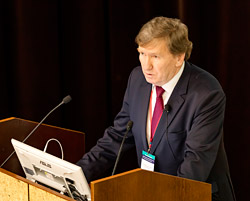 "Today we are opening the well-known conference "Parallel computational technologies" which is being held for the 16th time," Director of MLIT JINR Vladimir Korenkov said for the media of the Institute. "Its organizers are the Russian Academy of Sciences, the Ministry of Science and Higher Education of Russian Federation, Moscow State University, HPC Consortium of Russian Universities and many others. Every year this conference is held in different cities of Russia - university centers and for the first time in Dubna - in our Laboratory. We are glad to welcome specialists in the field of parallel computing and specialists in parallel computing applications. Today this is a very topical subject, highly-demanded, so we are waiting for interesting reports and discussions. I think this is a breakthrough subject matter for all Russian science and of course very essential one for the development of our Institute. Uniting supercomputers, uniting infrastructures, development of new algorithms and new methods - all this is an extremely important topic that will be discussed at the conference.
"Today we are opening the well-known conference "Parallel computational technologies" which is being held for the 16th time," Director of MLIT JINR Vladimir Korenkov said for the media of the Institute. "Its organizers are the Russian Academy of Sciences, the Ministry of Science and Higher Education of Russian Federation, Moscow State University, HPC Consortium of Russian Universities and many others. Every year this conference is held in different cities of Russia - university centers and for the first time in Dubna - in our Laboratory. We are glad to welcome specialists in the field of parallel computing and specialists in parallel computing applications. Today this is a very topical subject, highly-demanded, so we are waiting for interesting reports and discussions. I think this is a breakthrough subject matter for all Russian science and of course very essential one for the development of our Institute. Uniting supercomputers, uniting infrastructures, development of new algorithms and new methods - all this is an extremely important topic that will be discussed at the conference.
Almost the entire scientific Russia, a large number of universities, research centers, supercomputer centers are represented among the participants. The top 50 most powerful computers in Russia and the CIS countries today will be announced here."
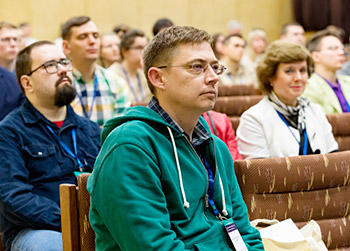 "What can MLIT demonstrate?"
"What can MLIT demonstrate?"
"We have a lot to show. First, this is an integrated computing infrastructure for experimental data modeling in the NICA project, primarily for MPD, where we have united our grid resources and our cloud resources, the "Govorun" supercomputer and other centers in Member States where mass modeling for the "Govorun" supercomputer is implemented. Quite intensive work is also carried out in the project of uniting three supercomputers: that of the Interdepartmental Supercomputer Center RAS, the supercomputer of the Polytechnic University of St.Petersburg and our "Govorun" supercomputer."
The participants of the conference were greeted by JINR Director Grigory Trubnikov, who noted the importance of MLIT's contribution to the scientific projects of the Institute and expressed his pride for the staff of the Laboratory. He thanked the conference partner companies that keep supporting the Institute. And afterwards Grigory Trubnikov made a report on "the present and future of the Institute, in which you are all needed for the implementation of our ambitious program."
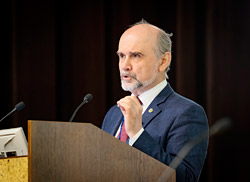 The plenary report "Supercomputer technologies, artificial intelligence and big data" by Vladimir Voevodin (MSU) was the first at the conference.
The plenary report "Supercomputer technologies, artificial intelligence and big data" by Vladimir Voevodin (MSU) was the first at the conference.
"Parallel computing is a global trend today," he said in an interview. "Although this trend occurred many years ago and today stands out conspicuously, regardless of whether we use large supercomputer systems or just tablets and mobile phones. If a young person wants to be an application developer, he should understand how to work with multiple cores so that everything he writes will be efficient and will use all the capabilities. At Moscow State University we have long begun to teach everything concerning parallel computing, supercomputer technologies. I started giving the first lectures back in the mid-1990s, later it was transformed into separate courses and now it is an integral element of the curriculum of the Faculty of Computational Mathematics and Cybernetics, the Faculty of Physics, the Faculty of Mechanics and other faculties.
At present a national supercomputer infrastructure is developed which allows to unite various supercomputer systems - somewhere to balance the loading, somewhere to use common management techniques. This is a direction that will develop. All IT companies have perceived the potential behind artificial intelligence technologies which require very serious computing resources. When we talk about practicing a neural network, it often takes weeks, after that it takes hours and days to optimize and after that the neural network works very fast. And since technologies are universal, any IT company that claims to have an ecosystem, whether it is Sber, Yandex, MTS or many others, is interested in spreading its technologies everywhere."
"You are not in Dubna for the first time..."
"I have got a very long-standing relationship with MLIT JINR, lasting for decades, I always come here with great pleasure. I'm in a way jealous, because the development is fast, there are new systems, new technologies and the emphasis on international cooperation is a great advantage. People work at the global level, it is pleasant and interesting to communicate with them.
Today a triad of high-performance computing, big data and artificial intelligence technologies develops. Any modern computing center one way or another considers all three areas together, they are interconnected: big data require serious processing, artificial intelligence technologies are applied to them. And this triad determines the development of any major computing center."
"What level of performance do supercomputers reach nowadays?"
"Today the ordinary level for supercomputers is petaFLOPS; the most powerful system is half an exaFLOPS (peta is 1015, exa is 1018 operations per second). Apparently, exascale systems will appear this year; everyone in the world gets ready for it. Indeed, this is an event, as developing, using, programming such systems is a challenge. It is difficult in many respects, but it is necessary, because there are more and more tasks requiring colossal resources, because everything can be calculated today."
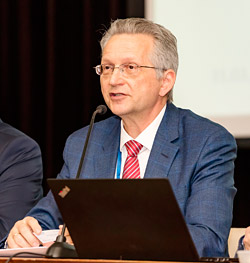 I learned about the history of the conference from Leonid Sokolinsky (South Ural State University, Chelyabinsk): The PCT conference was organized in 2007, when supercomputer technologies were extensively applied in Russian science and education and of course, in the world. It was a response to the global trend. The first conference was held at the South Ural State University, which together with the Moscow State University were organizers of this conference. It had a great success; at that time there was no intention to make it regular, but since the interest in this scope was very great, they decided to hold it annually and each time in different cities of Russia. Time has confirmed the efficiency of this approach, for 16 years it has become one of the leading and recognizable conferences. The proceedings of the conference are published by Springer publishing company, indexed in the Skopus and Web of Science databases, a collection of short articles and posters is also published, which is indexed by the Russian e-library RSCI (Russian Science Citation Index - O.T.). In addition, the best articles are published in leading journals that are included in the RSCI core and the list of HAC (Higher Attestation Commission). I would like to point out another characteristic feature of the PCN conference - a regular competition of reports made by young scientists. This competition is very popular and is also held at the current conference. The winners receive grants, a grant - for the first place, two grants - for the second place and three ones - for the third place, so there are quite a few winners. Grants are allocated from the sponsors of the conference amounting from 30 to 60 thousand rubles.
I learned about the history of the conference from Leonid Sokolinsky (South Ural State University, Chelyabinsk): The PCT conference was organized in 2007, when supercomputer technologies were extensively applied in Russian science and education and of course, in the world. It was a response to the global trend. The first conference was held at the South Ural State University, which together with the Moscow State University were organizers of this conference. It had a great success; at that time there was no intention to make it regular, but since the interest in this scope was very great, they decided to hold it annually and each time in different cities of Russia. Time has confirmed the efficiency of this approach, for 16 years it has become one of the leading and recognizable conferences. The proceedings of the conference are published by Springer publishing company, indexed in the Skopus and Web of Science databases, a collection of short articles and posters is also published, which is indexed by the Russian e-library RSCI (Russian Science Citation Index - O.T.). In addition, the best articles are published in leading journals that are included in the RSCI core and the list of HAC (Higher Attestation Commission). I would like to point out another characteristic feature of the PCN conference - a regular competition of reports made by young scientists. This competition is very popular and is also held at the current conference. The winners receive grants, a grant - for the first place, two grants - for the second place and three ones - for the third place, so there are quite a few winners. Grants are allocated from the sponsors of the conference amounting from 30 to 60 thousand rubles.
"How does the scope of the conference change, is it noticeable in the trend of global changes in information technology?"
"Yes, surely. The main core consists of parallel algorithms and technologies, but this is a very wide area and the peculiarity of the PCN conference is that it initially focuses on applications. Of course, there are reports on theoretical aspects of parallel computing technologies. As for significant changes in the scope, I would point out the occurrence of multi-core accelerators (Intel Xeon E5 accelerators, graphics accelerators from NVIDIA and other manufacturers) which, one might say, revolutionized the field of high-performance computing, to which a lot of attention was drawn at the conference. The second trend that I would like to mention is related to the tasks of artificial intelligence. Here the emphasis is on the issues of parallel distributed processing and there are more and more reports concerning this area."
"Will the conference being held at JINR this year have any impact on its development, will it lead to new cooperation?"
"Yes, it surely will. The experience of holding conferences has shown that it is especially during face-to-face communication, during such breaks between reports that future collaborations are developed, there is an exchange of views. Today Konstantin Barkalov made a report from two teams that traditionally participate in this conference - from Nizhny Novgorod and Ufa. We found the serious work of this collaboration and there are a lot of examples of such cooperation, many reports are made by the authors from different cities where the PCT conference was held. It was the conference that provided an opportunity to unite the efforts of researchers from different centers.
The fact that the conference is held at JINR today is extremely important, because the Joint Institute is a world-famous international organization that was one of the first in Russia where grid computing, distributed computing and distributed data processing were carried out. JINR has accumulated wide experience over the past years. Today we heard a brilliant report made by MLIT Director Vladimir Korenkov on the results achieved, enthusiastically accepted the proposals for further cooperation which I think will contribute to the further development and promotion of parallel and distributed computing technologies in Russia and the world."
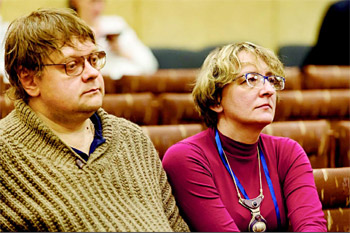 Dmitry Podgainy (JINR) made a report on "Implementation of the USI at the "Govorun" supercomputer" in the section "United supercomputer infrastructure":
Dmitry Podgainy (JINR) made a report on "Implementation of the USI at the "Govorun" supercomputer" in the section "United supercomputer infrastructure":
Our section at the conference is dedicated to the issues of development of a distributed computing environment. Last year we started this project of uniting supercomputers into a single, geographically distributed computing network. This is a new approach to the development of distributed computing, which in a sense is a generalization of both grid technologies and cloud computing. Such hybridization of approaches allows to directly unite HPC platforms, that is, supercomputers. This significantly increases the possibility of IT supercomputing: grid and cloud computing deal with a certain type of tasks, for example, processing experimental data from high energy physics. Our goal is to develop distributed computing that will be able to solve all types of tasks, including those that are calculated on local supercomputers. First of all, it is performed to increase the efficiency of using individual supercomputers. It is no secret that some supercomputers are overwhelmed, like our "Govorun", and we are interested in such an increase of our resources. Besides, it will allow to solve many tasks that are beyond the scope of a single local computing system. For example, primarily our supercomputer was developed comprehensively in order to solve the widest range of occurring tasks, as there are completely different types of tasks at the Institute - the ones facing LRB are very different from those solved at VBLHEP. We initially developed our computing machine so that it could solve everything.
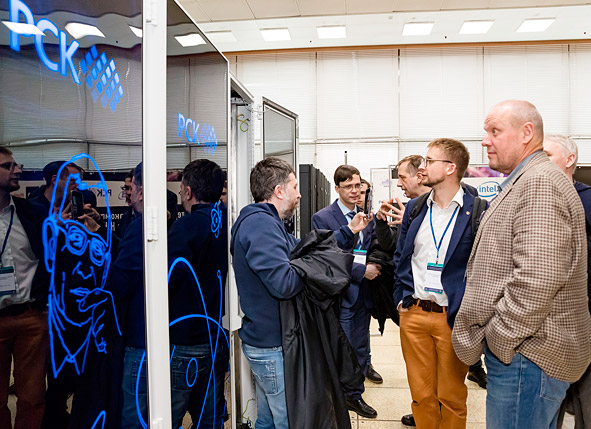
Most supercomputers in the world do not possess such flexibility; they are used to some extent to solve certain tasks. And when one unites various types of supercomputers, inside which there are different capabilities, this in particular allows users from other organizations to get access to various calculations, accelerating calculations, various methods of information processing, which is also important today in the field of working with big data. The processing of big data at large experimental facilities is a very urgent task, this is not only LHC, these are large telescopes and other physical facilities. And not only experiments, but also big data analytics require new methods and approaches. Supercomputers were not initially developed for this purpose, but now it is already clear that in addition to high computing power, such advanced technologies must be available. At our "Govorun" this naturally develops, we laid the possibility of working with big data from the very beginning, and even in the architecture of computing nodes. So when we create a joint infrastructure, users from other organizations don't just get access to some computing resources, but they get access to the latest technologies.
Also, in our section engineering reports will be made dedicated specifically to implementation issues, since creating such an environment is a non-trivial task. Representatives of the group of DCS companies, who actively participate and develop, including software, that would allow to implement the project, will make reports.
"How is the project of uniting supercomputers in the network going?"
"Now we are at the initial stage. We decided to use the MST supercomputer (Interdepartmental Supercomputing Center RAS), the supercomputer of the Polytechnic University of St. Petersburg and our "Govorun". We used them as a basis, because they possess a more or less similar architecture of nodes, so that we do not have to solve tasks concerning the heterogeneity of nodes and that of software. But in principle, we want to make our system universal, so that supercomputers of any other architecture can be included in it. In addition, one more feature of the system to be created: it is united via the NIKS network (the National Research Computer Network of Russia) - a research network for scientific organizations in the Russian Federation. So far we are within this network, but in principle we expect that we will include systems that are not connected to it. This will require a separate enhancement, but we hope that NIKS will continue to develop and all scientific organizations in Russia will be connected to it."
Olga Tarantina,
photo by Elena Puzynina